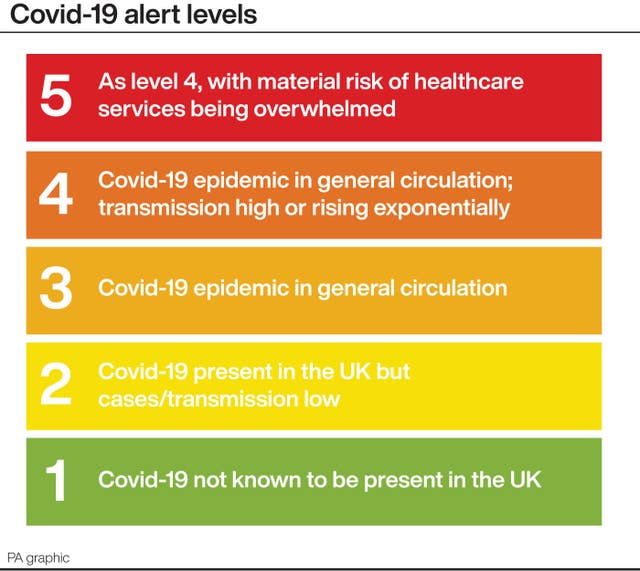Coronavirus alert level downgraded as cases continue to fall
Health Secretary Matt Hancock said moving to a lower alert level is a ‘big moment’ for the UK.

The UK’s chief medical officers have agreed to downgrade the coronavirus alert level from four to three after a “steady” and continuing decrease in cases in all four nations.
Localised outbreaks of Covid-19 are still “likely” to occur, the advisers warned, and the virus remains in general circulation.
But the downgrading – recommended by the Joint Biosecurity Centre (JBC) – means transmission of coronavirus is no longer considered to be “high or rising exponentially”.
Health Secretary Matt Hancock said moving to a lower alert level is a “big moment” for the UK, and showed the country is getting “back on her feet”.
England’s Professor Chris Whitty, Northern Ireland’s Dr Michael McBride, Scotland’s Dr Gregor Smith and Wales’ Dr Chris Jones agreed with the JBC’s recommendation.
They said: “The Joint Biosecurity Centre has recommended that the Covid-19 alert level should move from level four (a Covid-19 epidemic is in general circulation; transmission is high or rising exponentially) to level three (a Covid-19 epidemic is in general circulation).
“The CMOs for England, Scotland, Wales and Northern Ireland have reviewed the evidence and agree with this recommendation to move to level three across the UK.

“There has been a steady decrease in cases we have seen in all four nations, and this continues.
“It does not mean that the pandemic is over. The virus is still in general circulation, and localised outbreaks are likely to occur.
“We have made progress against the virus thanks to the efforts of the public and we need the public to continue to follow the guidelines carefully to ensure this progress continues.”
Mr Hancock said: “The UK moving to a lower alert level is a big moment for the country, and a real testament to the British people’s determination to beat this virus.
“The Government’s plan is working. Infection rates are rapidly falling, we have protected the NHS and, thanks to the hard work of millions in our health and social care services, we are getting the country back on her feet.”
But former chief scientific adviser to the Government Sir David King said that lowering the alert level was “a very strange decision to make at this point in time”.
Sir David, who chairs the Independent Sage group of scientists, told Channel 4 News: “The message that goes across when we reduce from four to three in this way is we seem to be winning the battle but the number of cases per day is still very high for the whole of England.”
Asked if the science was being massaged to follow the politics, he said: “I very much fear that is the case.
“I’m really questioning whether we’ve been following the science from the very beginning.”
However, Professor Matt Keeling, from the University of Warwick, said the move was “expected and is justified by the current epidemiological situation”, but warned that it is “not a time for complacency”.
“Our model-based assessment of the outbreak shows that cases are now at levels comparable with early March (before the lockdown began) and are continuing to fall, albeit slowly,” he said.
“The move to level three is a direct consequence of the public’s response to the social-distancing advice, but does not imply that these efforts should be relaxed. We cannot afford to lose the gains that have been made in controlling this outbreak.”
The easing of lockdown measures in England at the beginning of June caused concern as the Covid-19 alert level remained at four – which the Government previously said would mean restrictions remaining in place.
There was then confusion over whether the JBC was up and running, and what role it would play in setting the alert level.
The Covid Alert Levels system was announced by Prime Minister Boris Johnson in his televised address to the nation on May 10.
He said he was establishing the JBC to run the alert system, which is similar to that used to establish the terrorist threat.
It has five tiers from level one to five based on the spread of Covid-19 through the country.
At level five, transmission is high or rising and there is a risk healthcare services will be overwhelmed. Level one means coronavirus is no longer known to be in the UK.
Level three is when the epidemic is in general circulation and gradual easing of restrictions can take place, while level two is when the number of cases and transmission is low and “no or minimal” restrictions are required.





